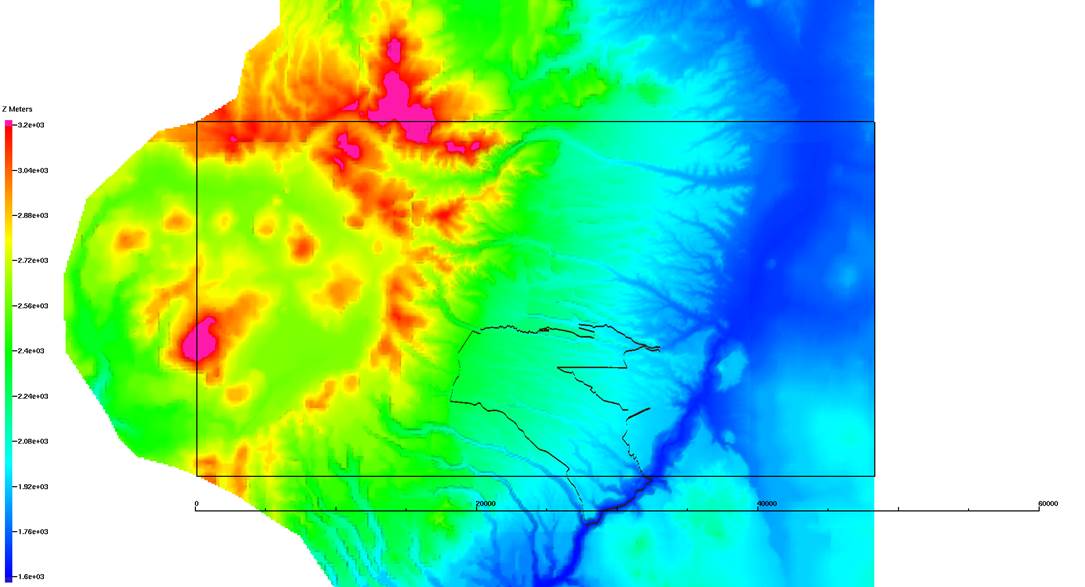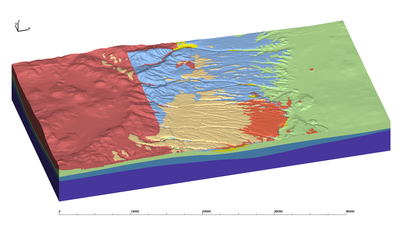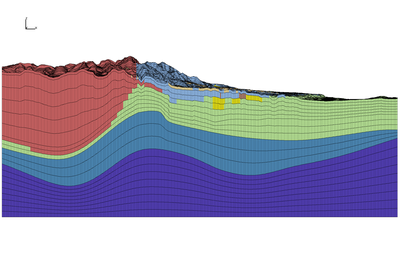Grid Project: Pajarito Basin Seismic Model
| Grid Team Member: |
Terry Miller |
| Grid Versions: |
V03 Large with Caldera and Rio Grande |
| Data Source: |
Cole 2005 Basin GFM |
| Delivered To: |
Carene Larmat and Richard Lee EES-17 |
| Date Completed: |
Feb 28 2014 to present |
| |
|
| Mesh Versions: |
|
| |
Basecase (pending prototype results) about 5 M cells |
| |
Proto Coarse with 1,728,720 cells |
| |
Simple with 411,600 cells |
Purpose of Project
Build a seismic model for the Pajarito Basin using a Geologic Framework Model to identify material layers.
The model includes all GFM materials including the deep Precambrian layer.
There may be more detailed geophysics in the future (seismic reflection) for defining structure in the Santa Fe/Precambrian interface.
The mesh domain was chosen to include the Rio Grande and as much of the Caldera feature as possible with a box shaped boundary. New mesh and model strategies are developed for Spectral Element Methods using LANL and commercial software applications.
Abstract
3D Modeling of Full Waveform Propagation to Evaluate Site Effects on Design Ground Motions at LANL.
Larmat, C., T. Miller, C. Gable and R. Lee
The 50-km-long Pajarito Fault System (PFS), extends along the western margin of Los Alamos National Laboratory (LANL). This proximity of LANL to the PFS implies unique ground motion design challenges to LANL with the further complication of the lack of empirical strong motion data in the near field for M 6-7 normal faulting earthquakes. The area is also characterized by a complex subsurface geology consisting of successive basalts flows, volcanic ash deposits and sedimentary units. Both structural features and topography can introduce strong frequency dependent amplification effects. In the last decade, new numerical methods have emerged allowing the modeling of full waveform propagation in complex 3D models. The Spectral Element Method (SEM) is one of the methods achieving remarkable accuracy and convergence performance.
In this paper, we present modeling results of wave propagation at LANL using SEM with a 3D seismic model built from available sources of information. A LIDAR model provides surface topography of mesa's and canyons and structural surface. Subsurface structure and stratigraphy are rendered by the 2005 Geologic Framework Model (GFM) developed for the Pajarito Basin for the LANL Hydrogeologic Workplan. The data of 31 regional wells completed since 1998 have been used to constrain transport properties. The SEM uses hexahedra meshes that cannot contain any degeneracies such as zero length edges or zero-volume elements. We construct the meshes selecting basin stratigraphy that form continuous layers without pinching out. All stratigraphic GFM materials are interpolated on to each mesh hexahedra. The result is a stair-step interface except along layers used in the mesh where the hexahedra conform to the stratigraphic layer. Ground motions resulting from different models will be compared. In addition, variability and uncertainty in elastic properties assigned to each GFM material will be explored using alternate seismic source scenarios.
Images of V03 Proto Coarse Mesh
Images showing work details
All Images for V03 work
Small Prototypes V01 and V02
Images of Full Basin Geologic Framework Model (GFM) Surfaces
Images of Basin Geologic Framework Model (GFM) Volumes within Mesh Domain
Top Surface Elevations
in area used for meshes

|
Mesh with Basin Geologic Materials

|
Image shows GFM area (colored by elevation)
Features include Caldera left, Rio Grande right
LANL Boundary outline
Full mesh boundary in box outline
Mesh Box Extents (Meters):
XMIN 462442.5625 XMAX 520110.7188
YMIN 519988.8125 YMAX 570097.9375
Bottom is flat with Z qual to -3000.
Top is variable with Z max near 3500.
|
9 TB4 - Cerros del Rio Basalt (salmon red)
8 TK - Keres Group (brick red)
7 QBT - Bandelier Tshirege Members (tan)
6 TPF - Puye Fanglomerate (blue)
5 TPT - Totavi, basal conglomerate of TPF (brown)
4 TF - Santa Fe Fanglomerate (yellow)
3 TSF - Santa Fe Silt and Sands (green)
2 PAL - Older Sedimentary (dark blue)
1 Pc - Pre-Cambrian (purple)
|
Mesh V03 Prototype Coarse
Full Hex Mesh

|
Sliced Hex Mesh 3x Exaggeration

|
Stacked Layers: 22
Number Elements: 1728720
Number Nodes: 1824306
Elements per layer: 82320
Nodes per layer: 82923
|
Material Cells Total Vol Min Vol. Max Vol.
TB4 9 7310 0.1554408E+11 1.0000000E+06 3.6312154E+06
TK 8 202219 0.8824879E+12 1.0000000E+06 1.0982574E+07
QBT2 7 16351 0.2820817E+11 1.0000000E+06 3.5147198E+06
TPF 6 34976 0.7695476E+11 9.0181651E+05 4.1562846E+06
TPT 5 2768 0.7485883E+10 1.0000000E+06 3.6339266E+06
TF 4 9378 0.2684372E+11 1.0000000E+06 3.7820506E+06
TSF 3 467878 0.1221346E+13 4.0184947E+05 6.2668281E+06
PAL 2 246960 0.1376521E+13 1.0000000E+06 1.3074442E+07
Pc 1 740880 0.2836728E+13 1.0000000E+06 5.8768127E+06
|
This mesh is a prototype that has fewer cells (but large volumes). It will guide resolution decisions for the final V03 base case mesh.
README file for V03 Prototype Coarse Mesh
Images for V03 Prototype Coarse Mesh
V03 Prototype Mesh Files
/scratch/sft/tam/grid_gen/SPECFEM3D/proto_v03_rio_caldera
These files have face sets for all 6 directions:
1 bottom HAS 82320 ELEMENTS
2 top HAS 82320 ELEMENTS
3 east HAS 4410 ELEMENTS
5 west HAS 4410 ELEMENTS
4 north HAS 8232 ELEMENTS
6 south HAS 8232 ELEMENTS
-rw-r--r-- tamiller sft 114456656 Mar 19 15:51 hex_allmat_fs6.exo
-rw-r--r-- tamiller sft 204065940 Mar 19 15:54 hex_allmat_fs6_ascii.exo
-rw-r--r-- tamiller sft 747187215 Mar 19 15:52 hex_allmat_fs6.exo.avs
-rw-r--r-- tamiller sft 237873960 Mar 19 15:52 hex_allmat_fs6.exo.gmv
-rw-r--r-- tamiller sft 81924 Mar 19 15:54 write_exo_allmat3.out
These files have 3 face sets:
1 bottom HAS 82320 ELEMENTS
2 top HAS 82320 ELEMENTS
3 sides HAS 25284 ELEMENTS
-rw-r--r-- tamiller sft 114456208 Mar 19 15:22 hex_allmat.exo
-rw-r--r-- tamiller sft 204065578 Mar 19 15:26 hex_allmat_ascii.exo
-rw-r--r-- tamiller sft 747187215 Mar 19 15:23 hex_allmat.exo.avs
-rw-r--r-- tamiller sft 237873960 Mar 19 15:23 hex_allmat.exo.gmv
-rw-r--r-- tamiller sft 73081 Mar 19 15:25 write_exo_allmat.out
Mesh V03 Prototype Simple (smallest version but same domain)
Full Hex Mesh

|
Sliced Hex Mesh 3x Exaggeration

|
Stacked Layers: 6
Number Elements: 411600
Number Nodes: 497538
Elements per layer: 82320
Nodes per layer: 82923
|
Material (layers) Cells Volume
100m from top 5 82320 0.1223645E+12
TSF middle and above 4 82320 0.1406358E+13
TSF and above 3 82320 0.7301481E+12
PAL 2 82320 0.1376521E+13
PC 1 82320 0.2836728E+13
|
This mesh is very simple with only 6 layers, but full domain. It has the fewest cells (very large volumes).
It is used to test that mesh files and formats are working.
README file for V03 Simple Mesh
Images for V03 Simple Mesh
V03 Simple Mesh Files
/scratch/sft/tam/grid_gen/SPECFEM3D/proto_v03_simple
These files have face sets for all 6 directions:
1 bottom HAS 82320 ELEMENTS
2 top HAS 82320 ELEMENTS
3 east HAS 1050 ELEMENTS
5 west HAS 1050 ELEMENTS
4 north HAS 1960 ELEMENTS
6 south HAS 1960 ELEMENTS
-rw-r--r-- tamiller sft 29774012 Mar 19 16:26 hex_allmat_fs6.exo
-rw-r--r-- tamiller sft 49882099 Mar 19 16:29 hex_allmat_fs6_ascii.exo
-rw-r--r-- tamiller sft 154734584 Mar 19 16:26 hex_allmat_fs6.exo.avs
-rw-r--r-- tamiller sft 89731552 Mar 19 16:26 hex_allmat_fs6.exo.gmv
-rw-r--r-- tamiller sft 75007 Mar 19 16:29 write_exo_allmat3.out
These files have 3 face sets:
1 bottom HAS 82320 ELEMENTS
2 top HAS 82320 ELEMENTS
3 sides HAS 6020 ELEMENTS
-rw-r--r-- tamiller sft 29773564 Mar 19 14:43 hex_allmat.exo
-rw-r--r-- tamiller sft 49881741 Mar 19 14:50 hex_allmat_ascii.exo
-rw-r--r-- tamiller sft 154734584 Mar 19 14:43 hex_allmat.exo.avs
-rw-r--r-- tamiller sft 89731552 Mar 19 14:43 hex_allmat.exo.gmv
-rw-r--r-- tamiller sft 66164 Mar 19 14:50 write_exo_allmat.out
Meshing Method
Initial strategy is the selection of basin surfaces that do not intersect or pinch-out. These surfaces are used to create a stacked hex mesh that follow the shape of surfaces used. The GFM materials are interpolated on to the hex mesh elements. These first prototypes will have coarse vertical resolution and materials will stair-step along all interfaces except those that were used in the stacking of the layers.
Step 1. Select basin surfaces that do not pinchout.
Step 2. Construct layers between surfaces and stack.
Step 3. Fill layers with hexahedral elements.
Step 4. Interpolate GFM materials on to hex elements.
Grid Team Contacts
| Carl Gable |
gable -at- lanl -dot- gov |
505-665-3533 |
| Terry Miller |
tamiller -at- lanl -dot- gov |
505-667-8009 |
